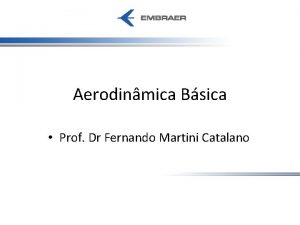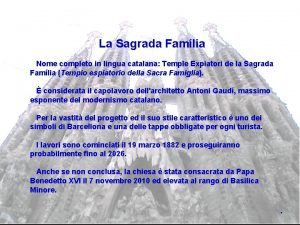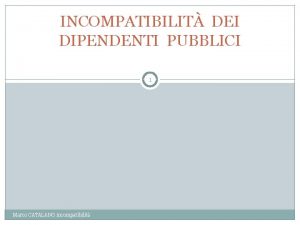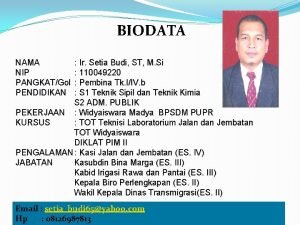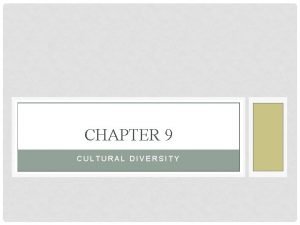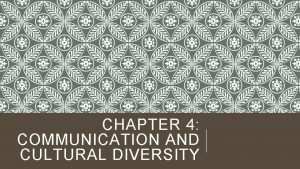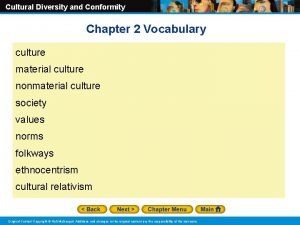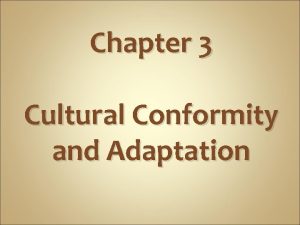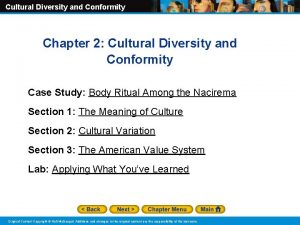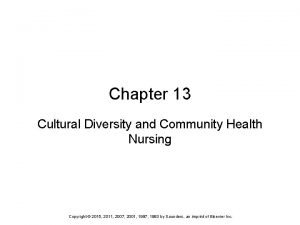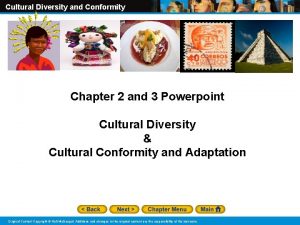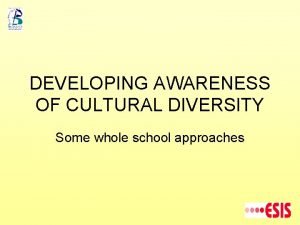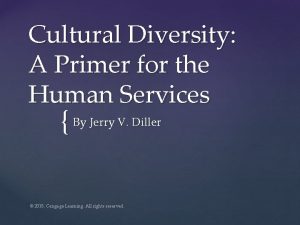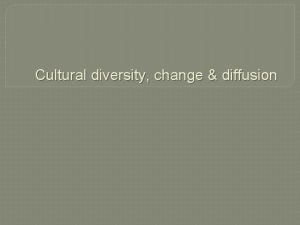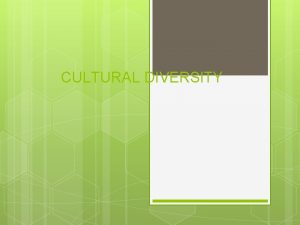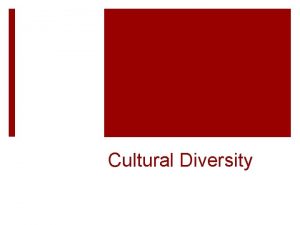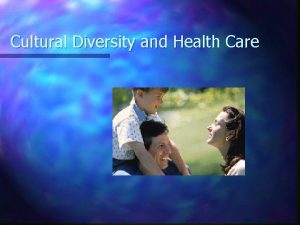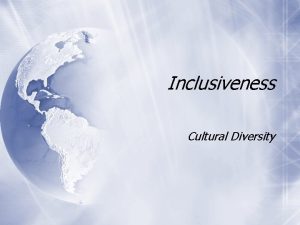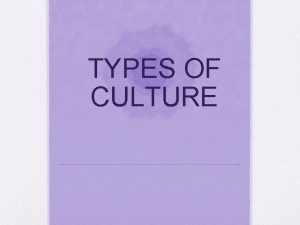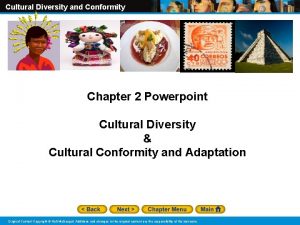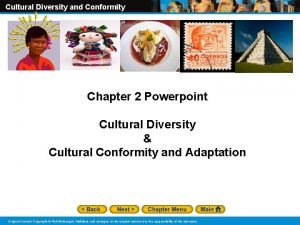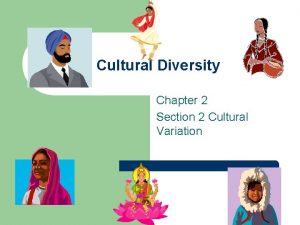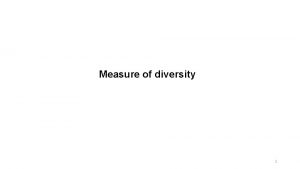Chapter 22 Cultural Diversity Joseph T Catalano Copyright

























- Slides: 25

Chapter 22 Cultural Diversity Joseph T. Catalano Copyright © 2015. F. A. Davis Company

Transcultural Nursing § Nurses who understand the essential characteristics of transcultural nursing will be able to provide competent and culturally sensitive care for clients from all cultural backgrounds. Copyright © 2015. F. A. Davis Company

What Is Culture? § Culture: a group’s acceptance of a set of attitudes, ideologies, values, beliefs, and behaviors that influence the way that the members of the group express themselves. Copyright © 2015. F. A. Davis Company

What Is Culture? (cont’d) § Cultural expression § Language; spirituality; works of art; music; group customs and traditions; food preferences; response to illness, stress, pain, bereavement, anger, and sorrow; decision-making; and even world philosophy Copyright © 2015. F. A. Davis Company

Cultural Orientation § The learning process starts at birth and continues throughout the life span. § Behaviors, beliefs, and attitudes are transmitted from one generation to the next. § Expressions of culture are primarily unconscious. § They have a profound effect on an individual’s interactions and response to the health-care system. Copyright © 2015. F. A. Davis Company

Concepts of Culture § Culture is not a monolithic concept. § Any individual belongs to several subcultures. § Subcultures develop when members of the group accept outside values in addition to those of their dominant culture. § Even within a given culture, many variations may exist. Copyright © 2015. F. A. Davis Company

Diversity § Explains the differences between cultures. § Primary characteristics are those that are more obvious, such as nationality, race, color, gender, age, and religious beliefs. Copyright © 2015. F. A. Davis Company

Diversity (cont’d) § Secondary characteristics are harder to identify, such as socioeconomic status, education, occupation, length of time away from the country of origin, gender issues, residential status, and sexual orientation. Copyright © 2015. F. A. Davis Company

Melting Pot Versus Salad Bowl § Melting pot: cultures try to “fit in” to the dominant culture by shedding the trappings of their native culture (acculturation). § Salad bowl: cultures cling tenaciously to their traditional cultural practices and languages in a minimal attempt to “fit in” (multiculturism). Copyright © 2015. F. A. Davis Company

Cultural Relativism § Cultural relativism occurs when members of a strong cultural group understand their culture and group members only from their own viewpoint rather than from that of the larger culture. § They do not try to understand its unique characteristics, values, and beliefs. Copyright © 2015. F. A. Davis Company

Heritage Consistency § It is a blending of the melting pot and the salad bowl together through a rather complex process. § Outwardly, they appear acculturated to the dominant culture. § At home or with groups from their traditional culture, they speak their native language, wear their traditional clothes, eat ethnically correct meals, and generally follow their native customs. Copyright © 2015. F. A. Davis Company

U. S. Ethnic Population Trends § 2000 census: approximately 30% of the U. S. population was composed of minority groups. § By 2050, the white population will actually be a minority group, constituting 48. 9% of the total population of the United States. § In some states, the white population will be a minority much sooner. Copyright © 2015. F. A. Davis Company

Need for Transcultural Nursing § The percentage of minority nurses does not reflect the national population trends. § Minority nurses have remained constant at approximately 10% of RNs. § The number of minority students enrolled in basic nursing programs remains at about 15%. Copyright © 2015. F. A. Davis Company

Developing Cultural Awareness § Awareness begins at home § Nurses develop cultural awareness only when they can recognize and value all aspects of a client’s culture, including beliefs, customs, responses, methods of expression, language, and social structure. § Merely learning about another person’s culture does not guarantee that the nurse will have cultural awareness. Copyright © 2015. F. A. Davis Company

Developing Cultural Awareness (cont’d) § To those unfamiliar with a particular culture’s health-care beliefs, many of the health-care practices may appear meaningless, strange, or even dangerous. § Beliefs about health care based in part on knowledge and are often related to religious beliefs. Copyright © 2015. F. A. Davis Company

Developing Cultural Awareness (cont’d) § Cultural belief systems § They are highly complex. § Beliefs practices are usually kept as closely guarded secrets. § There may even be some type of sanction or punishment for members who reveal the belief. § They develop over time from a trial-and-error process. Copyright © 2015. F. A. Davis Company

Developing Cultural Awareness (cont’d) § Cultural values § Sources § Religious beliefs § Worldview § Philosophy § Group customs Copyright © 2015. F. A. Davis Company

Developing Cultural Awareness (cont’d) § Changing the client’s health-care values § Recognize that the nurse comes from a particular culture that has its own set of health-care values. § Identify the culture of the client and recognize specific health-care practices. § Work with the client’s beliefs and cultural values to make changes that will improve health. Copyright © 2015. F. A. Davis Company

Cultural Assessment § Questions to ask § § Why do you think you are ill? What caused the illness? What was going on at the time the illness started? How does the illness affect your body and health? Do you consider this to be a serious illness? Copyright © 2015. F. A. Davis Company

Cultural Assessment (cont’d) § Questions to ask (cont’d) § If you were at home, what treatments or medications would you use? How would these treatments help? § What type of treatment do you expect from the health-care system? § How has your illness affected your ability to live normally? § If you do not get better, what do you think will happen? Copyright © 2015. F. A. Davis Company

Physical Variations in Assessment § The nurse must know the basic biological and physical variations among ethnic groups. § Findings may be affected by ethnic variations in anatomical structure or characteristics. § Changes in skin color may affect the interpretation of assessment findings. Copyright © 2015. F. A. Davis Company

Culturally Competent Care § Cultural competence as it relates to nursing is the provision of effective care for clients who belong to diverse cultures, based on the nurse’s knowledge and understanding of the values, customs, beliefs, and practices of the culture. § Primary skills required § Communication § Understanding § Sensitivity Copyright © 2015. F. A. Davis Company

Transcultural Communication § Barriers to communication § Lack of a common language § Not understanding nonverbal cues § Not understanding where men and women “fit” in the society § Using loud or aggressive tone of voice § Being confrontational Copyright © 2015. F. A. Davis Company

Transcultural Communication (cont’d) § Barriers (cont’d) § Nonverbal responses § Speech patterns § Personal information and trust § Open-ended language § Touch § Personal space § Eye contact Copyright © 2015. F. A. Davis Company

Transcultural Nursing § Elements for effective transcultural nursing § § Passive obedience Cultural synergy Building on similarities Conflict resolution Copyright © 2015. F. A. Davis Company
 Fernando martini catalano
Fernando martini catalano Catalano
Catalano Marco catalano corte dei conti
Marco catalano corte dei conti Menurut catalano, etika sebenarnya dapat dipahami sebagai
Menurut catalano, etika sebenarnya dapat dipahami sebagai Chapter 9 cultural competence
Chapter 9 cultural competence Chapter 4 communication and cultural diversity
Chapter 4 communication and cultural diversity 2009 delmar cengage learning
2009 delmar cengage learning Cultural diversity and conformity section 1
Cultural diversity and conformity section 1 Cultural diversity and conformity chapter test form a
Cultural diversity and conformity chapter test form a Cultural diversity and conformity section 1
Cultural diversity and conformity section 1 Culturological assessment
Culturological assessment Chapter 4 communication and cultural diversity
Chapter 4 communication and cultural diversity Why is genetic diversity important
Why is genetic diversity important Ecosystem jigsaw activity
Ecosystem jigsaw activity Melting pot vs salad bowl
Melting pot vs salad bowl Tcole 3939 answers
Tcole 3939 answers Cultural diversity and conformity section 3
Cultural diversity and conformity section 3 Cultural diversity examples
Cultural diversity examples Are west african bantu
Are west african bantu Zone of comfort phlebotomy
Zone of comfort phlebotomy Socio-cultural diversity
Socio-cultural diversity Whole school approach to cultural diversity
Whole school approach to cultural diversity Cultural diversity a primer for the human services
Cultural diversity a primer for the human services Cultural diversity and conformity section 2
Cultural diversity and conformity section 2 Cultural diversity means a range of different
Cultural diversity means a range of different Cultural diversity pros and cons
Cultural diversity pros and cons
